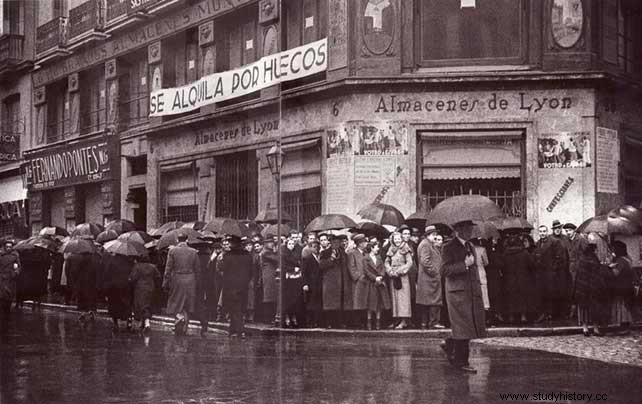Manuel Azaña Díaz was the Second President of the Second Republic . He was born on January 10, 1880 in Alcalá de Henares (Madrid). He studied Law in Madrid and Paris. His activity was divided between politics and letters. Between 1913 and 1920, he was secretary of the Ateneo de Madrid, of which he became President in 1930. Around that same date, he entered the Royal Academy of Jurisprudence and Legislation as a permanent academic, where, in 1933, he was promoted to the group of academics professors (academic professor it was just a rank; but he had nothing to do with being a teacher); This was explained by him, who was the secretary of that Academy when these events occurred, and he personally knew Azaña in that place because of his work. All this is also in accordance with article 8 of the Regulations of said Academy. Around those same dates, Azaña was also head of administration in the Faculty of the General Directorate of Registries and Notaries; as well as general secretary of the Institute of Comparative Law. On the other hand, he was director of the magazines La Pluma, Spain, and a collaborator in other national and foreign publications; he also published several works and received, in 1926, the National Prize for Literature .
Political career
At the advent of the Second Republic, he was part of the Provisional Government, as Minister of War; Without abandoning this portfolio, he also became President of the Government on October 14, 1931 (when Alcalá Zamora resigned that position, to be proclaimed president of the Republic), a position he resigned on September 8, 1933. In the general elections of November 19 of that same year, the CEDA (Spanish Confederation of Autonomous Rights) won. , while Azaña's party, Acción Republicana, only obtained five deputies; so, a few months later, on April 2, 1934, he founded the Republican Left party, under his presidency. Around this party, the Popular Front (electoral coalition made up of several left-wing parties) was formed, which won the elections on February 16, 1936, with which Azaña became head of government on February 19. that same month. After the dismissal of Alcalá Zamora as President of the Republic on April 7, 1936, Azaña was elected on the following May 10 to replace him. Then the reform program of the Popular Front began to be applied quickly:the prisoners of October 1934 were released through an amnesty; the Catalan Parliament was opened, which again elected Companys as president, and Catalan autonomy returned to function; the Cortes began to prepare the Basque Statute of Autonomy. It was decreed that the use and enjoyment of the lands that they had used years before be handed over to the yunteros. The Agrarian Reform Institute was authorized to occupy any farm (provisionally) that was considered to be of social utility. Labor relations became rarefied in the face of the attitude of the unions and of the workers themselves; many small employers began to close their businesses. The extreme right resorted to street violence. The agrarian conflict was great and was growing. In the province of Badajoz, as the lands had not yet been handed over to the yunteros, more than 60,000 of them occupied them; the Government accelerated the procedures for the expropriation of these lands:the land for those who work it, it was said; there were clashes with deaths between the Civil Guard and the peasants. The violence increased with murders on both sides. The Congress approved a program of organization of the society, with the week of thirty six hours of work; the expropriation without compensation of farms larger than fifty hectares, etc. The Statute of Autonomy of the Basque Country was almost all approved by Parliament, when Galicia, in a referendum on June 28, 1936, also decided its autonomy, on October 31, 1936 (already in the midst of civil war), the Court, approved the Statute of Autonomy of the Basque Country .

The violence continued to increase; an extreme right-wing commando killed assault lieutenant José del Castillo as he left his house on July 12, 1936; the replica took place the next day; At 3:00 a.m., a group of about twenty Assault Guards commanded by the captain of the Civil Guard, Cónde and they took him to the Eastern Cemetery, on the way he was killed. Two accomplice gravediggers must have been waiting to bury the body clandestinely in the common grave, so that no trace of the crime would remain; but something fortuitous meant that those two accomplices did not appear, so Captain Condé delivered the body to the gravediggers on duty (who knew nothing of what had happened) telling them that it was a night watchman who had been murdered in a Madrid street. The relatives and friends of the deceased could not find the body until twelve o'clock on the morning of that day, July 13, 1936. The fuse was lit. The military conspiracy of several generals, which had been brewing for some time, was ready to act, and the civil war began in Melilla on Friday, July 17, 1936. The next day, the Prime Minister, Casares Quiroga, resigned (since 14 from April 1931 to this date, July 18, 1936, there were sixteen Governments in the Second Republic); then, by order of Azaña, José Giral formed another Government, to face this war that had just begun, which ended on April 1, 1939. Azaña, who, on April 15, 1936. Azaña went to France on January 4, 1939 and, on February 27 of that same year, he sent his resignation as President of the Second Republic to Martínez Barrio, President of the Cortes. Azaña died on November 3, 1940 in Montuban (France).
